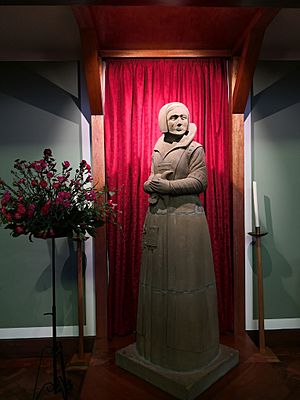Anne Line facts for kids
Quick facts for kids SaintAnne Line |
|
|---|---|

|
|
| Martyr | |
| Born | c. 1563 Essex, England |
| Died | 27 February 1601 (aged 38 - 39) Tyburn, England |
| Venerated in | Catholic Church Anglican Communion |
| Beatified | 15 December 1929 by Pope Pius XI |
| Canonized | 25 October 1970 by Pope Paul VI |
| Feast | 27 February (individual) 25 October (together with Forty Martyrs of England and Wales) 30 August (together with Saints Margaret Ward and Margaret Clitherow) |
| Attributes | dove, noose in neck, book or bible, |
| Patronage | childless people, converts, widows |
Anne Line (born around 1563 – died February 27, 1601) was a brave English Catholic martyr. During the time of Queen Elizabeth I, it was against the law to be Catholic or to help Catholic priests. After her husband died, Anne secretly helped many Catholic priests by giving them a safe place to stay. Because of this, she was arrested and sentenced to death. Anne Line is now honored as a saint by the Catholic Church. Pope Paul VI made her a saint in 1970.
Contents
Life Story of Anne Line
Anne Line was likely born as "Alice Higham" or "Heigham" around the early 1560s. She was the oldest daughter of William Higham, a Puritan (a type of Protestant). Her grandfather, Roger Heigham, was a Member of Parliament and a Protestant reformer.
Becoming Catholic
In the early 1580s, Anne, her brother William, and Roger Line (whom she married in February 1583) all became Catholic. This was a difficult decision because being Catholic was not allowed by the government at that time. Both Roger Line and William Higham lost their inheritance for changing their religion. Anne also lost her dowry (money or property given by a bride's family). After her marriage, "Alice" became known as "Anne" among Catholics.
Challenges and Help for Priests
Roger Line and William Higham were arrested while attending a Catholic Mass. They were put in prison and had to pay a fine. William Higham was later released, but Roger Line was sent away to Flanders (a region in Europe). Roger received some money from the King of Spain, and he regularly sent part of it to Anne until he died around 1594.
Around this time, a Jesuit priest named John Gerard started a secret house where Catholic priests could hide. He asked Anne Line to manage this house, even though she was often sick. For about three years, Anne Line bravely ran this safe house while Father John Gerard was in prison. He was later moved to the Tower of London, where he was tortured, but he managed to escape.
Arrest and Execution
Anne Line was arrested on February 2, 1601. This happened when her house was raided during a special Catholic celebration called the feast of the Purification (also known as Candlemas). During this celebration, candles are traditionally blessed before Mass. It was during this blessing that officers burst in and made arrests.
The priest, Father Francis Page, managed to hide in a secret place Anne Line had prepared and later escaped. However, Anne was arrested along with another woman named Margaret Gage. Margaret Gage was later released, but Anne Line was sent to Newgate Prison.
Trial and Sentence
Anne Line's trial took place on February 26, 1601. She was so weak from a fever that she had to be carried to the court in a chair. During the trial, she bravely told the court that she did not regret helping a priest. She even said she wished she "could not receive a thousand more." Sir John Popham, the judge, sentenced her to death. Her crime was helping a Catholic priest, which was against the law.
Anne's Final Words
Anne Line was hanged on February 27, 1601, at Tyburn. She was executed just before two priests, Roger Filcock and Mark Barkworth. At the scaffold (the platform where executions took place), Anne repeated her strong belief. She told everyone watching: "I am sentenced to die for harbouring a Catholic priest, and so far I am from repenting for having so done, that I wish, with all my soul, that where I have entertained one, I could have entertained a thousand."
Honoring Anne Line
Anne Line was recognized as a blessed person by Pope Pius XI on December 15, 1929. She was then made a saint by Pope Paul VI on October 25, 1970. She is one of the Forty Martyrs of England and Wales, a group of saints who died for their Catholic faith in England.
Her feast day, along with other English Martyrs, is on May 4. However, in Catholic areas of England, she shares a special feast day with two other female martyr saints, Margaret Clitherow and Margaret Ward, on August 30.
Several places are named after Saint Anne Line. The St. Anne Line Catholic Junior School in Basildon, Essex, is named for her. There is also a Catholic church called St Anne Line in Great Dunmow, Essex. Local stories say her family once lived in the Clock House there. Another Catholic church, St Anne Line in South Woodford, London, also honors her and has a large stone statue of her inside.
See also


